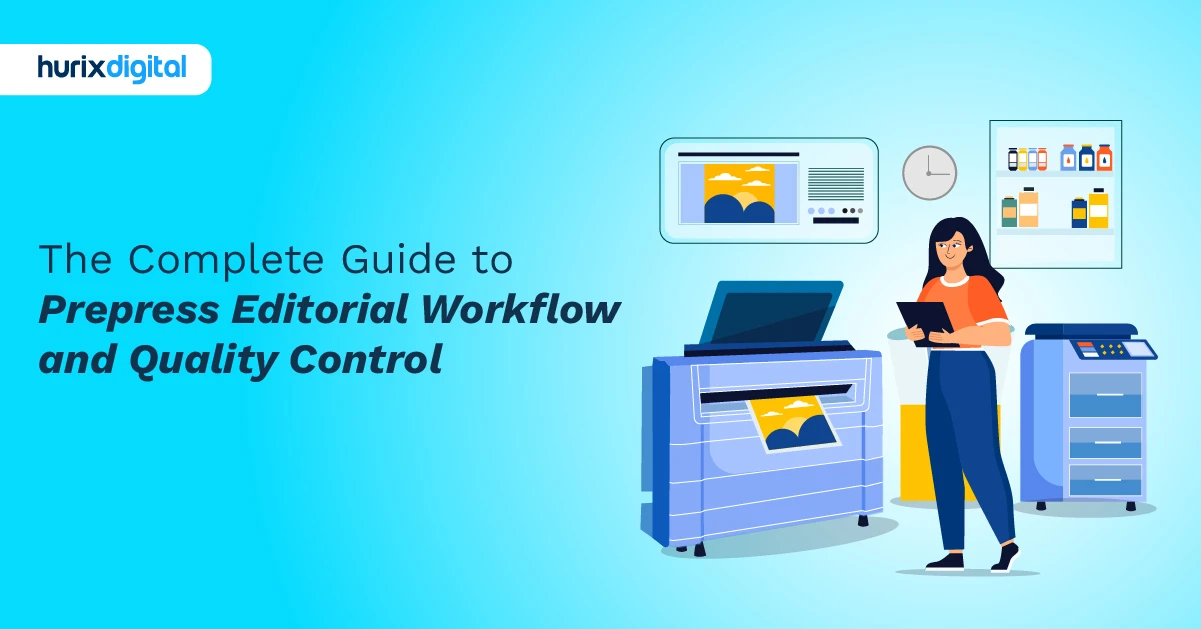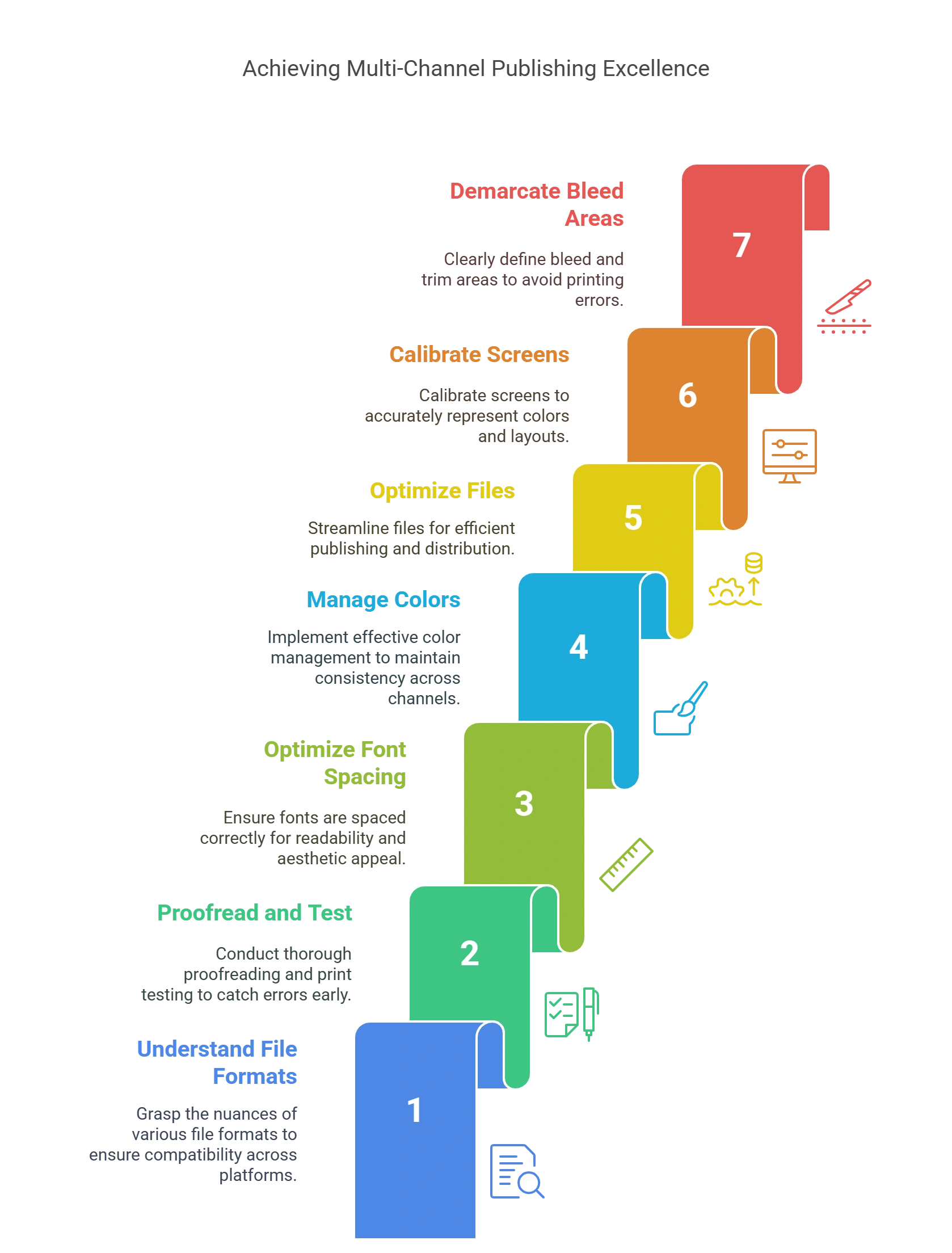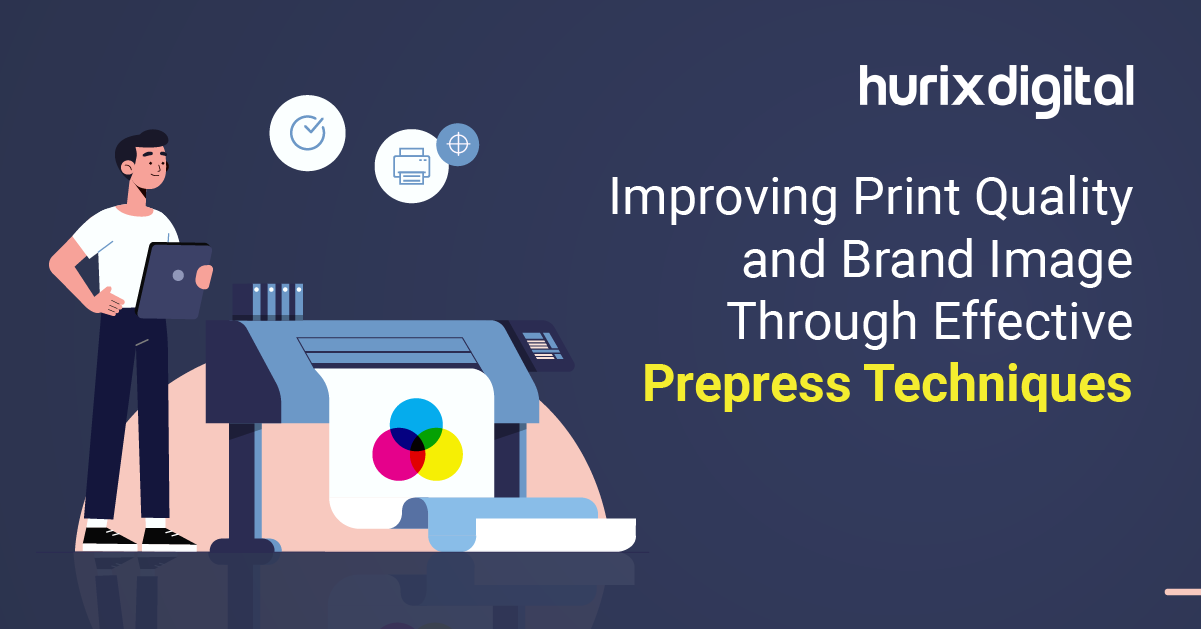
Best Practices and Quality Control in Prepress Editorial Services
Summarize with:
Prepress services serve as the crucial link between creative vision and the final printed masterpiece in the publishing world. This intricate process involves meticulous adjustments to images and text, coupled with the creation of impeccable print files. It sets the stage for a flawless print outcome.
Industry experts project that prepress errors contribute to printing delays and reprints, amounting to a significant 30% of Value Added Sales (VAS) annually. Consequently, adhering to best prepress practices becomes paramount for streamlining workflows and minimizing costs within the dynamic realm of the printing industry.
In this post, we cover practices for prepress services that will help ensure a smooth and efficient printing process while minimizing errors and costs. Let’s start!
Table of Contents:
- What are Prepress Services?
- Ways to Leverage Prepress Services for Multi-Channel Publishing Experience
- Top 7 Ways to Ensure Accessibility Compliance with Prepress Services
- To Wrap Up
What are Prepress Services?
In the print and publishing sectors, prepress refers to the methods and procedures that take place between the development of a print layout and the final printing.
The prepress process includes illustration curation for press, choice of media, editing, quality control inspections, and, if necessary, printing plate creation.
Role of Quality Control in Prepress Services
Making sure the content is flawless, consistent, and of the highest caliber before it is printed is the main goal of quality control in prepress editorial services.
This includes proofreading for spelling and grammar mistakes, ensuring the formatting is correct, examining the quality of the images, and ensuring the content is accurate and in line with the intended layout.
Strong quality control procedures can help prepress editors identify possible problems early in the process and address them before the final product is produced.

7 Key Procedures Associated with Quality Control
Prepress editorial services use quality control to make sure the content satisfies predetermined editorial standards through some procedures and inspections. These procedures could consist of:
1. Proofreading
An essential part of quality control is proofreading, in which editors carefully review the text to fix any typos in grammar, punctuation, or spelling. Even following the initial proofreading, there is typically some likelihood of errors occurring, which can become evident during the typesetting and design stages of the project.
Proofreading processes guarantee that the text is lucid, cohesive, and error-free, all of which could affect the final product’s readability and reliability.
2. Verification of Images
Images are essential for improving the visual appeal of printed materials. During quality control, editors ensure that all images are high-resolution, correctly aligned, and in the appropriate size and format.
Choosing the incorrect resolution for an image is a frequent mistake in prepress printing. The best option is to select an image resolution between 250 and 300 dpi (dots per inch).
In addition to resolution, it is important to ensure that the selected images are not resized (either maximized or decreased) by more than 20% of their original size, as this can impact resolution. Erroneous resizing of the images may also result in different preparation problems before the copy is sent for final printing.
3. Formatting Check
To keep the content’s overall look and feel consistent, prepress editorial services must use consistent formatting.
Editors must make sure that all formatting elements, including headings and subheadings, are consistent and adhere to the established style guidelines. Any variations from the rules must be fixed to keep the formatting consistent.
4. Color Management
Color management is the method of regulating and preserving color accuracy from layout to the finished printed product at every step of print production. The goal of color management is to ensure that the colors displayed on the computer screen properly correspond to the colors printed on the finished product.
The three primary steps in the color management process are conversion, calibration, and profiling. Using color management tools in the prepress workflow is crucial to applying color management correctly in the field.
5. Accuracy of Content
In prepress editorial services, content accuracy is of utmost importance.
Editors must ensure that all facts, figures, and information included in the content are accurate and up to date. Correcting any errors or discrepancies is imperative to avoid the spread of disinformation and preserve the credibility of the finished output.
6. Optimize Font Spacing
Text spacing must be optimized for print publishing to be as successful as possible. The best approach in this case is to adhere to traditional typographic practices, like modifying your text to produce a distinctive appearance that sets your design apart from competitors.
Making your writing look attractive and cohesive while considering different elements like letters, punctuation, paragraphs, and negative space is the goal here.
7. Select the Appropriate Paper
Successful print publishing greatly depends on the choice of paper. Once you have all the design aspects and are just one step away from submitting your final layout to print, this is an essential component you should take care of.
To help with the selection process, keep in mind that different kinds of print paper have distinct feels and looks, so it’s crucial to choose one that suits your work, genre, and budget.

Best Practices for Implementing Quality Control in Prepress Services
Following are some of the best practices crucial for implementing quality control in prepress editorial services:
1. Creating Standard Operating Procedures (SOPs)
Developing standardized quality control processes and workflows can help guarantee effectiveness and uniformity in the prepress editorial process. SOPs should specify the procedures for quality control, the duties and responsibilities of team members, and the standards by which the content will be judged.
2. Performing Numerous Review Rounds
Multiple rounds of review should be part of prepress services to identify errors and inconsistencies efficiently.
Various team members can evaluate the material at different phases to offer new insights and spot any problems that may have gone unnoticed. Collaborative review procedures can raise the general quality of the content.
3. Using Software and Automated Tools
Software and automation tools can help prepress editorial services’ quality control procedures to run more smoothly. Grammar checkers, spell checkers, and formatting software can help find mistakes more swiftly, freeing up editors to work on more complex quality control tasks.
4. Having Effective Client Communications
Prepress services must communicate openly with clients to comprehend their needs, wants, and expectations. Periodic notifications, feedback meetings, and progress updates can ensure that the final product is in line with the client’s vision and goals.
Check out EXCLUSIVE: Hurix Mini-Book: PrePress Tips You Won’t Find Anywhere Else
10 Ways to Optimize Prepress Editorial Workflows
Prepress has a significant impact on workflow efficiency.
Below are the best practices that you can implement to optimize your prepress editorial workflows and ensure a seamless printing process:
1. Ace Your Graphics
Choosing the right image quality is crucial for achieving crisp, professional-looking prints.
To ensure clarity, aim for a resolution between 250 and 300 dpi (dots per inch). Do not resize images by more than 20%, as this can drastically reduce their quality and lead to blurry or pixelated prints.
Also, avoid enlarging or shrinking the image and try to maintain its original size. Minimal adjustments instead of major changes can preserve the image details and avoid potential printing issues down the line.
2. Choose Your Software Wisely
Efficient prepress workflows hinge on selecting the appropriate software. While tools like Microsoft Word or PowerPoint might suffice for regular documents, professional printing demands more robust solutions. There are innumerable choices for pre-press editorial services for image manipulation, design, vector graphics, and other versatile design capabilities.
These specialized programs offer advanced features and precise control over elements essential for high-quality printing. They ensure design consistency is taken care of and tackle any challenges you face to give you a smooth and efficient prepress process.
3. Proofreading is a Must!
Scrupulous content proofreading stands as a cornerstone of prepress editorial services. While design elements capture your readers’ attention, error-free text is of equal importance as it shows the credibility of your work and leaves a lasting impression. Do not let avoidable prepress errors overshadow your brilliant work.
Potential issues like text overflows, obscured content by images, or misplaced text can surface after initial proofreading processes during typesetting.
Prepress services prioritize thorough content review to prevent costly reprints and delays. It scrutinizes typos, grammatical errors, and layout inconsistencies, guaranteeing a polished final product and a hassle-free workflow.
4. Space Out
The visual appeal and readability of a text in print publications require attention. Prepress editorial services should adhere to established typographic practices in addition to simple line spacing adjustments.
Editorial services involve fine-tuning elements like leading (space between lines), tracking (letter spacing), and kerning (space between specific letter combinations).
Editors can carefully adjust these parameters to create a unique and balanced text layout that enhances readability and sets your design apart. Optimal spacing ensures rich aesthetics and a cohesive flow in your text and prevents potential printing issues.
5. Pay Attention to the Color
Achieving accurate color representation in print demands vigilance during prepress editorial services. A fundamental difference exists between how colors are displayed on screens (RGB) and reproduced by printers (CMYK). Screens blend light to create colors, while printers use inks to subtract them.
Prepress services run checks to ensure your design is seamlessly recreated on paper from the screen.
Editors safeguard against unexpected color variations and guarantee a visually consistent final product by verifying color modes and potentially converting from RGB to CMYK. Such a proactive approach streamlines the prepress workflow and minimizes the risk of costly reprints.
6. Ensure Preflighting
Preflighting is the culmination of all prepress editorial services. It is a final check that ensures everything is in order before printing.
Preflighting can be manual or software-assisted, depending on your preference. It examines various aspects like font consistency, color accuracy, and image resolution, safeguarding against potential issues like blurry prints, incorrect layouts, or missing elements.
It serves as a demo run-through for your text before printing to keep the hassle of reprinting at bay. It prevents several expenses and ensures that your final printed product is of premium quality.
7. Make Room for Bleeds
Bleeds help in achieving visually stunning edge-to-edge printing. Editors extend an image or background slightly beyond the intended page size to ensure prepress optimization.
Due to mechanical limitations, printers cannot print right to the edge, so bleeds avoid unwanted white margins with some trimming variations. Prepress editorial standards include bleed requirements to avoid trimming issues and guarantee a high-quality, professional-looking printed piece.
8. The Paper You Choose Matters
Selecting the optimal paper stock is a crucial step in the prepress workflow. Beyond aesthetics, paper choice significantly impacts the feel and visual appeal of the final product.
Prepress editorial services play a vital role in guiding this decision. Understanding the diverse characteristics of various paper types helps individuals make an informed decision.
From weight and texture to finish and compatibility with printing techniques, careful consideration ensures the chosen paper complements the design and elevates the overall printing experience. Thus, choose wisely because your paper choice can make or break your final product.
9. Check the PDF Quality
Imagine navigating through a PDF document with blurry text and pixelated images—not an ideal reading experience, right? Just as you wouldn’t tolerate it, your readers expect the best. Relying solely on default settings from an online editor won’t cut it for achieving seamless printing results.
Most printers have specific requirements for the final PDF quality. Prepress editorial services ensure optimal workflows by understanding these printer specifications and exporting PDFs accordingly. Such attention to detail guarantees high-resolution files and eliminates potential printing pitfalls.
10. Run a Final Check
Thoroughly scrutinizing your files before sending them for final printing is essential to optimizing the prepress process. Prepress editorial services ensure a smooth workflow by addressing important aspects like exporting the final document as a high-resolution PDF to guarantee clarity and avoid faulty printing.
Prepress services send images separately, regardless of embedding, to provide the printer with readily accessible, high-quality files.
These services also verify that the source file uses fonts readily available to the printer to eliminate font substitution issues. By addressing these concerns, prepress optimization minimizes delays and communication gaps and ensures the printer has all the necessary resources for a successful printing run.
To Wrap Up
Staying updated on evolving trends and advancements is crucial for success in the dynamic world of prepress services. Minor prepress mistakes can lead to costly delays and reprints. Adopting the best practices outlined in this article helps you optimize your workflow, minimize errors, and ensure seamless printing.
On this note, partner with a trusted prepress service provider like Hurix Digital to maximize efficiency and attain flawless results. By implementing the best practices highlighted in this article, we can help you streamline your workflow, reduce errors, and achieve a seamless printing process.
Contact us to learn more about our services!
Summarize with:

Vice President – Content Transformation at HurixDigital, based in Chennai. With nearly 20 years in digital content, he leads large-scale transformation and accessibility initiatives. A frequent presenter (e.g., London Book Fair 2025), Gokulnath drives AI-powered publishing solutions and inclusive content strategies for global clients
 Upcoming Masterclass | Build an Army of Brand Evangelists using Training & Development | November 20th, 8:30 AM PDT | 11:30 AM EDT | 10:00 PM IST
Upcoming Masterclass | Build an Army of Brand Evangelists using Training & Development | November 20th, 8:30 AM PDT | 11:30 AM EDT | 10:00 PM IST




